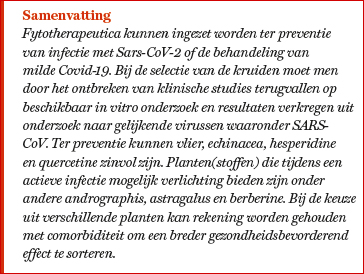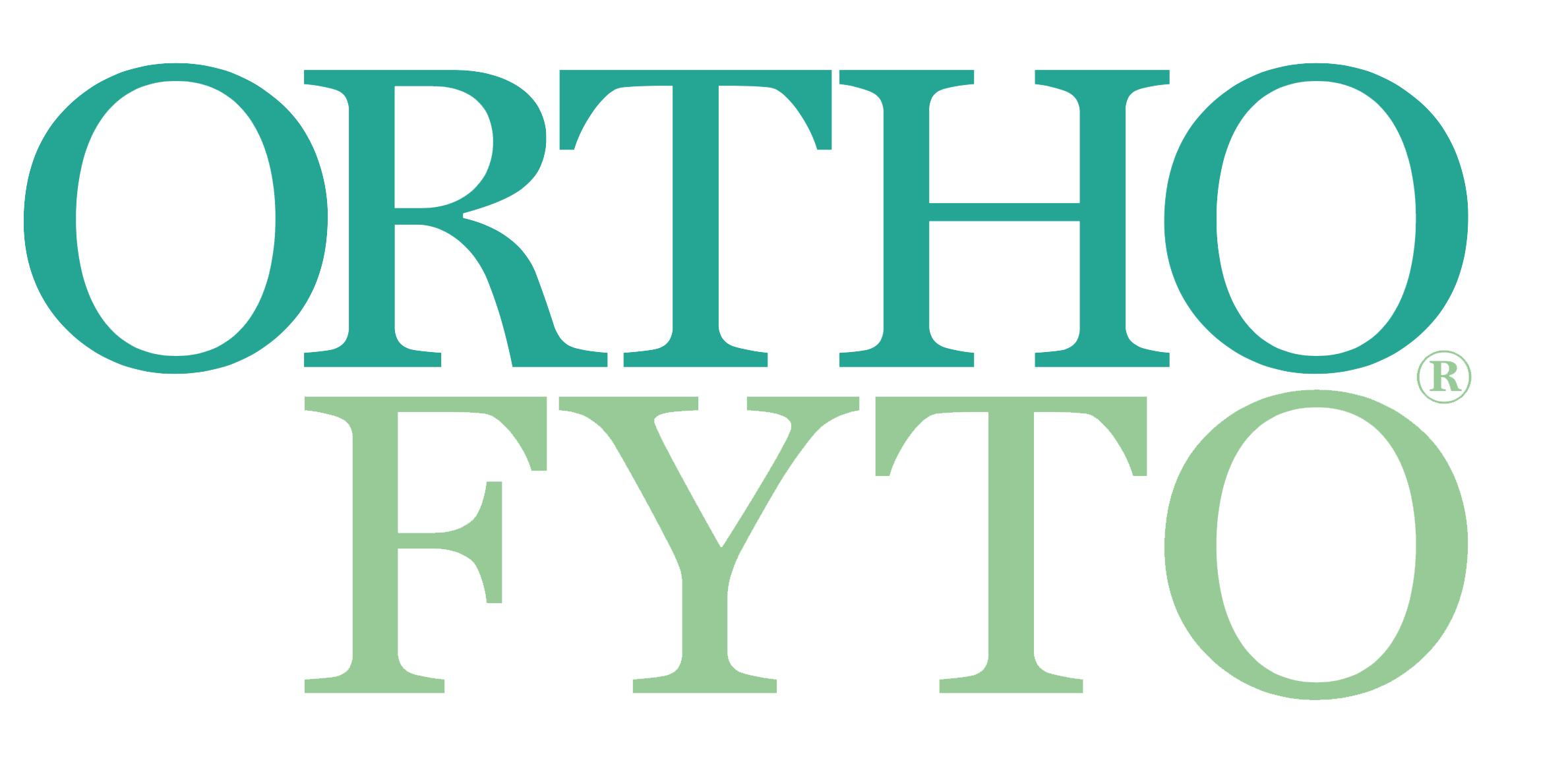Kruiden en SARS-CoV-2
05 May, 2020
Door: Cindy de Waard
 Er zijn geen klinische studies gedaan naar kruidengebruik bij een infectie met het nieuwe SARS-CoV-2. Toch bestaat er wel een vraag welke fytotherapeutica mogelijk ondersteuning kunnen bieden ter preventie van infectie en behandeling van milde COVID-19. We kunnen daartoe teruggrijpen op kennis over plantengebruik bij luchtweginfecties en andere (corona)virussen.
Er zijn geen klinische studies gedaan naar kruidengebruik bij een infectie met het nieuwe SARS-CoV-2. Toch bestaat er wel een vraag welke fytotherapeutica mogelijk ondersteuning kunnen bieden ter preventie van infectie en behandeling van milde COVID-19. We kunnen daartoe teruggrijpen op kennis over plantengebruik bij luchtweginfecties en andere (corona)virussen.
Voor de selectie van kruiden ten behoeve van gebruik bij het SARS-CoV-2 coronavirus moeten we terugvallen op in vitro–onderzoek en data verkregen uit onderzoek met gelijkende virussen.1 In dit kader dient u de volgende uiteenzetting over kruidengebruik bij SARS-CoV-2 dan ook te plaatsen als u overweegt kruiden in te zetten in de professionele setting. Er zijn verschillende studies gedaan met Chinese kruiden(formules). Bij de selectie van de kruiden is er rekening mee gehouden dat de planten ook een traditie hebben in de Westerse fytotherapie of het gebruik hier bekend is. Vanzelfsprekend kunnen kruiden alleen gebruikt worden ter preventie of ondersteuning bij milde klachten. Na genezing van een longontsteking kunnen kruiden daarnaast mogelijk het herstel van longweefsel ondersteunen.
De immunologische reactie van het lichaam verloopt bij een SARS-CoV-2 infectie voor zo ver bekend in drie fases. Tijdens de eerste fase dringt het virus het lichaam binnen door binding van het spike-eiwit aan de ACE2-receptor in longweefsel en is het in staat zich daar te repliceren. In de daaropvolgende fase wordt het virus door het lichaam gedetecteerd door activatie van een groep eiwitten in het cytoplasma, het NLRP3 inflammasoom, en ontstaat er een pro-inflammatoire immuunreactie die resulteert in het vrijkomen van de cytokinen interleukine (IL) 1b en IL-18 uit macrofagen en T-helpercellen. Gedurende de derde fase dient de pro-inflammatoire ontstekingsreactie gereguleerd uitgeschakeld te worden om zware weefselschade te voorkomen. Bij een groep ernstig zieke mensen ontstaat er echter een overreactiviteit van het immuunsysteem die resulteert in een cytokinestorm die weefschade veroorzaakt aan lever, nieren en longen.
Lees het gehele artikel vanaf pagina 22 in OrthoFyto 3/20. Wilt u het gehele artikel als PDF bestand ontvangen? Bestel het dan hier voor € 3,50. Bronvermelding:- Yang Y, Islam S, Wang J, Li Y, Chen X. Traditional Chinese Medicine in the Treatment of Patients Infected with 2019-New Coronavirus (SARS-CoV-2): A Review and Perspective. Int J Biol Sci. 2020;2020(10):1708–17.
- Zhou F, Yu T, Du R, Fan G, Liu Y, Liu Z, et al. Clinical course and risk factors for mortality of adult inpatients with COVID-19 in Wuhan, China: a retrospective cohort study. Lancet. 2020 Mar 28;395(10229):1054–62.
- Engler O, Strasser M, Signer J, Schoop R. Neutralizing activity of Echinacea purpurea on Coronaviruses including highly pathogenic Middle-East-Respiratory Syndrome Virus (MERS-CoV). In: 65th International Congress and Annual Meeting of the Society for Medicinal Plant and Natural Product Research (GA 2017). Georg Thieme Verlag KG; 2017. p. Tu-PO-241.
- Schwarz S, Sauter D, Wang K, Zhang R, Sun B, Karioti A, et al. Kaempferol derivatives as antiviral drugs against the 3a channel protein of coronavirus. Planta Med. 2014 Feb;80(2–3):177–82.
- Jo S, Kim S, Shin DH, Kim MS. Inhibition of SARS-CoV 3CL protease by flavonoids. J Enzyme Inhib Med Chem. 2020 Jan 1;35(1):145–51.
- Utomo RY, Ikawati M, Meiyanto E. Revealing the Potency of Citrus and Galangal Constituents to Halt SARS-CoV-2 Infection. preprints.org. 2020 Mar 12;2(March):1–8.
- Chen F, Chan KH, Jiang Y, Kao RYT, Lu HT, Fan KW, et al. In vitro susceptibility of 10 clinical isolates of SARS coronavirus to selected antiviral compounds. J Clin Virol. 2004 Sep 1;31(1):69–75.
- Martínez-Noguera FJ, Marín-Pagán C, Carlos-Vivas J, Rubio-Arias JA, Alcaraz PE. Acute effects of hesperidin in oxidant/antioxidant state markers and performance in amateur cyclists. Nutrients. 2019 Aug 1;11(8).
- Heinz SA, Henson DA, Austin MD, Jin F, Nieman DC. Quercetin supplementation and upper respiratory tract infection: A randomized community clinical trial. Pharmacol Res. 2010 Sep;62(3):237–42.
- Han MK, Barreto TA, Martinez FJ, Comstock AT, Sajjan US. Randomised clinical trial to determine the safety of quercetin supplementation in patients with chronic obstructive pulmonary disease. BMJ Open Respir Res. 2020 Feb 17;7(1).
- Cinatl J, Morgenstern B, Bauer G, Chandra P, Rabenau H, Doerr HW. Glycyrrhizin, an active component of liquorice roots, and replication of SARS-associated coronavirus. Lancet. 2003 Jun 14;361(9374):2045–6.
- Wei X, Zhu X, Hu N, Zhang X, Sun T, Xu J, et al. Baicalin attenuates angiotensin II-induced endothelial dysfunction. Biochem Biophys Res Commun. 2015 Jul 31;465(1):101–7.
- Zakay-Rones Z, Thom E, Wollan T, Wadstein J. Randomized study of the efficacy and safety of oral elderberry extract in the treatment of influenza A and B virus infections. J Int Med Res. 2004;32(2):132–40.
- Todd DA, Gulledge T V, Britton ER, Oberhofer M, Leyte-Lugo M, Moody AN, et al. Ethanolic Echinacea purpurea Extracts Contain a Mixture of Cytokine-Suppressive and Cytokine-Inducing Compounds, Including Some That Originate from Endophytic Bacteria. Bach H, editor. PLoS One. 2015 May 1;10(5):e0124276.
- Barak V, Birkenfeld S, Halperin T, Kalickman I. The effect of herbal remedies on the production of human inflammatory and anti-inflammatory cytokines. Isr Med Assoc J. 2002 Nov 1;4(11 Suppl):919–22.
- Jayakumar T, Hsieh C-Y, Lee J-J, Sheu J-R. Experimental and Clinical Pharmacology of Andrographis paniculata and Its Major Bioactive Phytoconstituent Andrographolide. Evidence-Based Complement Altern Med. 2013;2013:1–16.
- Brush J, Mendenhall E, Guggenheim A, Chan T, Connelly E, Soumyanath A, et al. The effect of Echinacea purpurea, Astragalus membranaceus and Glycyrrhiza glabra on CD69 expression and immune cell activation in humans. Phyther Res. 2006 Aug;20(8):687–95.
- Winston D, Maimes S. Adaptogens: herbs for strength, stamina, and stress relief. Healing Arts Press; 2007. 324 p. ISBN 9781594771583
- Melissae folium (Melissa leaf) - Online consultation - ESCOP [Internet]. [cited 2020 Apr 9].
- Cecil CE, Davis JM, Cech NB, Laster SM. Inhibition of H1N1 influenza A virus growth and induction of inflammatory mediators by the isoquinoline alkaloid berberine and extracts of goldenseal (Hydrastis canadensis). Int Immunopharmacol. 2011 Nov 1;11(11):1706–14.
- Hydrastis rhizoma (Goldenseal rhizome) - Online consultation - ESCOP [Internet]. [cited 2020 Apr 9].
- Kumar A, Chopra K, Mukherjee M, Pottabathini R, Dhull DK. Current knowledge and pharmacological profile of berberine: An update. Eur J Pharmacol. 2015;761:288–97.
